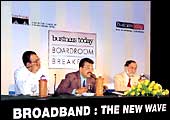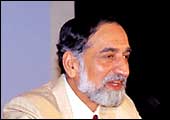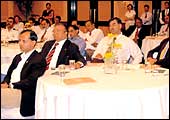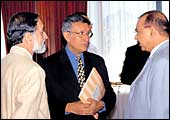 |
| Key notes: (L-R) R. Sukumar, Executive
Editor, Business Today, Sudhir Narang, Senior Vice President,
Cisco Systems and Kiran Karnik, President, Nasscom, deliberate
on issues facing broadband adoption in India at the BT Boardroom
Breakfast |
April
19, 2005, saw the bigwigs of Indian industry assemble at the Nilgiri
Hall in the Oberoi Hotel, New Delhi, to participate in a discussion
on "Broadband: The New Wave". Despite the 8.30 a.m.
start to the seventh Business Today Boardroom Breakfast (organised
in association with Cisco Systems India), the speakers-Kiran Karnik,
President, Nasscom and Sudhir Narang, Senior Vice President, Cisco
Systems, and moderator R. Sukumar, Executive Editor, Business
Today-and the audience had a stimulating enough time to dispel
any regrets of sleep lost.
First off the mark was Karnik, who argued
that although broadband is a technology with great potential,
there were still things that needed to be done on the policy front,
particularly with regard to last-mile connectivity. "We need
to unbundle the last mile for broadband to actually take off.
We need that badly to bring in competition so that costs and prices
come down, and availability goes up," he said.
But last-mile connectivity was not the only
thing on Karnik's agenda. In his view, the next, more critical
issue was what was going to be carried on it. "Clearly, the
driver is going to be and has to be applications. The crux of
the cable penetration in India, for example, was the fact that
there was compelling content. If you want broadband to penetrate
widely, it has to be applications that drive it," he asserted.
Taking over from Karnik, Cisco's Narang felt
that there had to be some corrections apart from the last mile.
His primary concern was whether pc penetration could be brought
up to the kind of volumes needed to nab 20 million broadband users
and 40 million internet users. His recipe for broadband mania:
"First, there has to be a converged platform; there has to
be services and applications convergence. Also, there has to be
a significant change in market approach, convergence on infrastructure
and a different approach for different business models."
Narang also felt that in future, voice, video and data on broadband
would be media independent.
 |
 |
"For broadband
mania to happen, there has to be services and applications
convergence"
Sudhir Narang
Senior Vice President,
Cisco Systems |
"Broadband can
liberate us from the concept of working in a physically bound
location"
Kiran Karnik
President,
NASSCOM |
It wasn't just Karnik and Narang who aired
their views; the audience also had its chance. Moderator Sukumar
queried Manav Sethi, National Manager (Sales & Strategic Alliances),
Webdunia, the first Indian ISP to offer vernacular services as
far back as in 2000, on what was required to increase broadband
penetration in rural areas. Sethi felt that broadband could be
used as the medium for the rural populace to access applications
that would be people-centric. "Many of these (applications)
will have to be in local languages. We just can't do without (local)
languages," he said.
Rajat Mukarji, VP (Corporate Affairs), Idea
Cellular, commenting on the potential of wireless broadband, felt
that wireless broadband in its current form would probably not
be able to provide end-to-end connectivity, because of the dearth
of handsets and the fact that the technology itself was not tried
and tested. But he was hopeful of change. "In a year and
a half, there will be technologies that will support wireless
broadband and devices that will connect to wireless broadband.
Applications and services then will drive usage in that area,"
he remarked.
Usage, of course, is largely driven by what
customers are willing to pay for. N. Arjun, CEO (Long-distance
Services), Airtel, held forth on the issue. "The customer
now is increasingly paying for quality, and a lowering of rates
should spur the market on. Quality and applications-though I don't
see applications coming in the next 18 months-are what they are
going to pay for," said Arjun.
 |
 |
 |
| Enraptured: The industry
circuit finds lots to ponder and exchange notes over when
the discussion revolves around broadband |
A dampner came from Rohit Tandon, CIO of GE,
who felt that there was no pressing need for companies to move
away from their current infrastructure to broadband. "Unless
we can figure out how you can make a quantum leap in the way you
are doing business by moving to broadband, I don't see a huge
demand from the corporate sector," remarked Tandon.
Karnik, though, had the last word: "One
of the things that broadband can do is liberate the concept of
working in a physically bound location." We all look forward
to that day!
|









